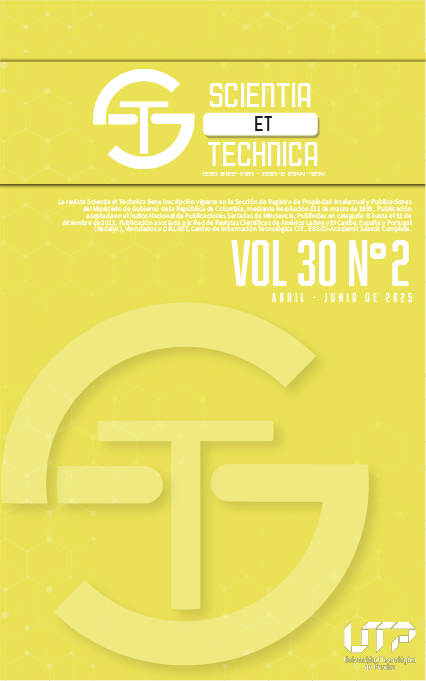Implementation of ANFIS +NN and nature-inspired optimization algorithms for solar radiation prediction
DOI:
https://doi.org/10.22517/23447214.25682Keywords:
ANFIS, Neural Networks, , Optimization Algorithms, , Solar Radiation Prediction, Fuzzy SystemsAbstract
This article presents a hybrid model that uses ANFIS (adaptive neuro-fuzzy inference system) hybridized with neural networks (NN) and optimized with algorithms based on natural behaviors, specifically ant colony optimization (ACO). The model is designed to predict primary resources in a specific region targeted for the planning and installation of distributed photovoltaic (PV) generation. The solar primary resource depends on the climatic conditions of the region to be evaluated, and its high variability over short periods presents a challenge in planning energy resources that rely on variable sources in the long term. In this study, the behavior of a hybrid ANFIS + NN + ACO model is designed, developed, evaluated, and validated. The methodology, based on data analysis, is detailed. First, work is carried out on climatic databases, which provide guidelines for preprocessing and cleaning. Second, the climatic variables used to predict solar radiation are identified. ANFIS membership functions are then based on the data to capture nonlinearity and extract relationships with predictors. Neural networks support the optimization of the membership functions, and finally, the optimizer refines and evaluates the response. The response is evaluated using metrics that demonstrate the robustness of the model in capturing and processing data. This study contributes by highlighting tools and alternatives to determine energy potential in climatic regions subject to future distributed generation.
Downloads
References
F. O. Hocaoĝlu, "Stochastic approach for daily solar radiation modeling," Solar Energy, vol. 85, no. 2, pp. 278-287, 2011, doi: 10.1016/j.solener.2010.12.003.
https://doi.org/10.1016/j.solener.2010.12.003
E. Obando-Paredes and R. Vargas-Cañas, "Desempeño de un sistema fotovoltaico autónomo frente a condiciones medioambientales de una región en particular," Rev Acad Colomb Cienc Exactas Fis Nat, vol. 40, no. 154, pp. 27-33, 2016, doi: 10.18257/raccefyn.301.
https://doi.org/10.18257/raccefyn.301
Z. M. Yaseen et al., "Implementation of Univariate Paradigm for Streamflow Simulation Using Hybrid Data-Driven Model: Case Study in Tropical Region," IEEE Access, vol. 7, pp. 74471-74481, 2019, doi: 10.1109/ACCESS.2019.2920916.
https://doi.org/10.1109/ACCESS.2019.2920916
E. D. Obando, S. X. Carvajal, and J. Pineda, "Solar radiation prediction using machine learning techniques: a review," IEEE Latin America Transactions, vol. 17, no. 4, pp. 684-697, 2019.
https://doi.org/10.1109/TLA.2019.8891934
R. Claywell, L. Nadai, I. Felde, S. Ardabili, and A. Mosavi, "Adaptive neuro-fuzzy inference system and a multilayer perceptron model trained with grey wolf optimizer for predicting solar diffuse fraction," Entropy, vol. 22, no. 11, pp. 1-14, Nov. 2020, doi: 10.3390/e22111192.
https://doi.org/10.3390/e22111192
M. Sharafi and T. Y. ElMekkawy, "Stochastic optimization of hybrid renewable energy systems using sampling average method," Dec. 01, 2015, Elsevier Ltd. doi: 10.1016/j.rser.2015.08.010.
https://doi.org/10.1016/j.rser.2015.08.010
V. H. Quej, J. Almorox, J. A. Arnaldo, and L. Saito, "ANFIS, SVM and ANN soft-computing techniques to estimate daily global solar radiation in a warm sub-humid environment," J Atmos Sol Terr Phys, vol. 155, pp. 62-70, Mar. 2017, doi: 10.1016/j.jastp.2017.02.002.
https://doi.org/10.1016/j.jastp.2017.02.002
H. Ishibuchi and Y. Nojima, "Analysis of interpretability-accuracy tradeoff of fuzzy systems by multiobjective fuzzy genetics-based machine learning," International Journal of Approximate Reasoning, vol. 44, no. 1, pp. 4-31, 2007, doi: 10.1016/j.ijar.2006.01.004. https://doi.org/10.1016/j.ijar.2006.01.004
C. Bergmeir and M. Ben, "frbs : Fuzzy Rule-Based Systems for Classification," J Stat Softw, vol. 65, no. 6, pp. 1-30, 2015, doi: 10.18637/jss.v069.i12.
https://doi.org/10.18637/jss.v069.i12
H. Ghazvinian et al., "Integrated support vector regression and an improved particle swarm optimization-based model for solar radiation prediction," PLoS One, vol. 14, no. 5, May 2019, doi: 10.1371/journal.pone.0217634.
https://doi.org/10.1371/journal.pone.0217634
M. Restrepo, C. A. Cañizares, J. W. Simpson-Porco, P. Su, and J. Taruc, "Optimization- and Rule-based Energy Management Systems at the Canadian Renewable Energy Laboratory microgrid facility," Appl Energy, vol. 290, no. October 2020, 2021, https://doi.org/10.1016/j.apenergy.2021.116760
E. Obando-Paredes, "Algoritmos genéticos y PSO aplicados a un problema de generación distribuida . PSO and genetic algorithms applied to a distributed generation problem," vol. 22, no. 1, pp. 15-23, 2017, doi: https://doi.org/10.22517/23447214.14301.
E. Group, "FUZZY ALGORITHM FOR ESTIMATION OF SOLAR IRRADIATION," vol. 63, no. 1, pp. 39-49, 1998.
https://doi.org/10.1016/S0038-092X(98)00043-7
A. Khosravi, R. O. Nunes, M. E. H. Assad, and L. Machado, "Comparison of artificial intelligence methods in estimation of daily global solar radiation," J Clean Prod, vol. 194, pp. 342-358, Sep. 2018, doi: 10.1016/j.jclepro.2018.05.147.
https://doi.org/10.1016/j.jclepro.2018.05.147
B. Mohammadi and Z. Aghashariatmadari, "Estimation of solar radiation using neighboring stations through hybrid support vector regression boosted by Krill Herd algorithm," Arabian Journal of Geosciences, vol. 13, no. 10, May 2020, doi: 10.1007/s12517-020-05355-1.
https://doi.org/10.1007/s12517-020-05355-1
K. Mohammadi, S. Shamshirband, C. W. Tong, K. A. Alam, and D. Petković, "Potential of adaptive neuro-fuzzy system for prediction of daily global solar radiation by day of the year," Energy Convers Manag, vol. 93, pp. 406-413, Mar. 2015, doi: 10.1016/j.enconman.2015.01.021.
https://doi.org/10.1016/j.enconman.2015.01.021
L. M. Halabi, S. Mekhilef, and M. Hossain, "Performance evaluation of hybrid adaptive neuro-fuzzy inference system models for predicting monthly global solar radiation," Appl Energy, vol. 213, pp. 247-261, Mar. 2018, doi: 10.1016/j.apenergy.2018.01.035.
https://doi.org/10.1016/j.apenergy.2018.01.035
S. Riahi, E. Abedini, M. Vakili, and M. Riahi, "Providing an accurate global model for monthly solar radiation forecasting using artificial intelligence based on air quality index and meteorological data of different cities worldwide", doi: 10.1007/s11356-021-14126-8/Published.
L. Zou, L. Wang, L. Xia, A. Lin, B. Hu, and H. Zhu, "Prediction and comparison of solar radiation using improved empirical models and Adaptive Neuro-Fuzzy Inference Systems," Renew Energy, vol. 106, pp. 343-353, 2017, doi: 10.1016/j.renene.2017.01.042.
https://doi.org/10.1016/j.renene.2017.01.042
H. Tao et al., "Global solar radiation prediction over North Dakota using air temperature: Development of novel hybrid intelligence model," Energy Reports, vol. 7, pp. 136-157, Nov. 2021, doi: 10.1016/j.egyr.2020.11.033.
https://doi.org/10.1016/j.egyr.2020.11.033
H. Huang, S. S. Band, H. Karami, M. Ehteram, K. wing Chau, and Q. Zhang, "Solar radiation prediction using improved soft computing models for semi-arid, slightly-arid and humid climates," Alexandria Engineering Journal, vol. 61, no. 12, pp. 10631-10657, Dec. 2022, doi: 10.1016/j.aej.2022.03.078.
https://doi.org/10.1016/j.aej.2022.03.078
V. Nourani, G. Elkiran, J. Abdullahi, and A. Tahsin, "Multi-region Modeling of Daily Global Solar Radiation with Artificial Intelligence Ensemble," Natural Resources Research, vol. 28, no. 4, pp. 1217-1238, Oct. 2019, doi: 10.1007/s11053-018-09450-9.
https://doi.org/10.1007/s11053-018-09450-9
Mohammadi, Kasra, S. Shamshirband, D. Petković, and H. Khorasanizadeh, "Determining the most important variables for diffuse solar radiation prediction using adaptive neuro-fuzzy methodology; Case study: City of Kerman, Iran," Renewable and Sustainable Energy Reviews, vol. 53, pp. 1570-1579, 2016, doi: 10.1016/j.rser.2015.09.028.
https://doi.org/10.1016/j.rser.2015.09.028
A. Khosravi, R. O. Nunes, M. E. H. Assad, and L. Machado, "Comparison of artificial intelligence methods in estimation of daily global solar radiation," J Clean Prod, vol. 194, pp. 342-358, 2018, doi: 10.1016/j.jclepro.2018.05.147.
https://doi.org/10.1016/j.jclepro.2018.05.147
L. M. Halabi, S. Mekhilef, and M. Hossain, "Performance evaluation of hybrid adaptive neuro-fuzzy inference system models for predicting monthly global solar radiation," Appl Energy, vol. 213, no. November 2017, pp. 247-261, 2018, doi: 10.1016/j.apenergy.2018.01.035.
https://doi.org/10.1016/j.apenergy.2018.01.035
V. H. Quej, J. Almorox, J. A. Arnaldo, and L. Saito, "ANFIS, SVM and ANN soft-computing techniques to estimate daily global solar radiation in a warm sub-humid environment," J Atmos Sol Terr Phys, vol. 155, no. February, pp. 62-70, 2017, doi: 10.1016/j.jastp.2017.02.002.
https://doi.org/10.1016/j.jastp.2017.02.002
R. Claywell, L. Nadai, I. Felde, and S. Ardabili, "Adaptive Neuro-Fuzzy Inference System and a Multilayer Perceptron Model Trained with GreyWolf Optimizer for Predicting Solar Di use Fraction," Entropy, vol. 22, no. 1192, 2020.
https://doi.org/10.3390/e22111192
S. Riahi, E. Abedini, M. Vakili, and M. Riahi, "Providing an accurate global model for monthly solar radiation forecasting using artificial intelligence based on air quality index and meteorological data of different cities worldwide," Environmental Science and Pollution Research, vol. 28, no. 36, pp. 49697-49724, 2021, doi: 10.1007/s11356-021-14126-8.
https://doi.org/10.1007/s11356-021-14126-8
L. Zou, L. Wang, L. Xia, A. Lin, B. Hu, and H. Zhu, "Prediction and comparison of solar radiation using improved empirical models and Adaptive Neuro-Fuzzy Inference Systems," Renew Energy, vol. 106, pp. 343-353, 2017, doi: 10.1016/j.renene.2017.01.042.
https://doi.org/10.1016/j.renene.2017.01.042
H. Tao et al., "Global solar radiation prediction over North Dakota using air temperature: Development of novel hybrid intelligence model," Energy Reports, vol. 7, pp. 136-157, 2021, doi: 10.1016/j.egyr.2020.11.033.
https://doi.org/10.1016/j.egyr.2020.11.033
H. Huang, S. S. Band, H. Karami, M. Ehteram, K. wing Chau, and Q. Zhang, "Solar radiation prediction using improved soft computing models for semi-arid, slightly-arid and humid climates," Alexandria Engineering Journal, vol. 61, no. 12, pp. 10631-10657, 2022, doi: 10.1016/j.aej.2022.03.078.
https://doi.org/10.1016/j.aej.2022.03.078
Mohammadi, Kasra, S. Shamshirband, C. W. Tong, K. A. Alam, and D. Petković, "Potential of adaptive neuro-fuzzy system for prediction of daily global solar radiation by day of the year," Energy Convers Manag, vol. 93, pp. 406-413, 2015, https://doi.org/10.1016/j.enconman.2015.01.021
V. Nourani, G. Elkiran, J. Abdullahi, and A. Tahsin, "Multi-region Modeling of Daily Global Solar Radiation with Artificial Intelligence Ensemble," Natural Resources Research, vol. 28, no. 4, pp. 1217-1238, 2019, doi: 10.1007/s11053-018-09450-9.
https://doi.org/10.1007/s11053-018-09450-9
K. Mohammadi, S. Shamshirband, D. Petković, and H. Khorasanizadeh, "Determining the most important variables for diffuse solar radiation prediction using adaptive neuro-fuzzy methodology; Case study: City of Kerman, Iran," Jan. 01, 2016, Elsevier Ltd. doi: 10.1016/j.rser.2015.09.028.
https://doi.org/10.1016/j.rser.2015.09.028
O. Castillo and P. Melin, "Optimization of type-2 fuzzy systems based on bio-inspired methods: A concise review," Inf Sci (N Y), vol. 205, pp. 1-19, Nov. 2012, doi: 10.1016/j.ins.2012.04.003.
https://doi.org/10.1016/j.ins.2012.04.003
M. Sengupta et al., "Best Practices Handbook for the Collection and Use of Solar Resource Data for Solar Energy Applications.," Technical Report - NREL/TP-5D00-63112, no. February, pp. 1-255, 2015, doi: 10.1016/j.solener.2003.12.003.
https://doi.org/10.1016/j.solener.2003.12.003
C. Voyant et al., "Machine learning methods for solar radiation forecasting: A review," 2017, Elsevier Ltd. doi: 10.1016/j.renene.2016.12.095.
https://doi.org/10.1016/j.renene.2016.12.095
NASA, " Prediction of Worldwide Energy Resource (POWER)
S. A. Pérez-Rodríguez et al., "Metaheuristic Algorithms for Solar Radiation Prediction: A Systematic Analysis", doi: 10.1109/ACCESS.2017.DOI.
A. I. Galushkin, Neural Networks Theory. 2007.
L. Ma, N. Yorino, and K. Khorasani, "Solar radiation (insolation) forecasting using constructive neural networks," Proceedings of the International Joint Conference on Neural Networks, vol. 2016-Octob, no. 3, pp. 4991-4998, 2016, doi: 10.1109/IJCNN.2016.7727857.
https://doi.org/10.1109/IJCNN.2016.7727857
S. S. Screening et al., "Solar resource assessment and site evaluation using remote sensing methods," Fraunhofer ISE, vol. 1, no. February, p. 162, 2015, doi: Fraunhofer ISE.
Downloads
-
Vistas(Views): 257
- PDF (Español (España)) Descargas(Downloads): 196
Published
How to Cite
Issue
Section
License
Copyright (c) 2025 Scientia et Technica

This work is licensed under a Creative Commons Attribution-NonCommercial-ShareAlike 4.0 International License.
Copyrights
The journal is free open access. The papers are published under the Creative Commons Attribution / Attribution-NonCommercial-NoDerivatives 4.0 International - CC BY-NC-ND 4.0 license. For this reason, the author or authors of a manuscript accepted for publication will yield all the economic rights to the Universidad Tecnológica of Pereira free of charge, taking into account the following:
In the event that the submitted manuscript is accepted for publication, the authors must grant permission to the journal, in unlimited time, to reproduce, to edit, distribute, exhibit and publish anywhere, either by means printed, electronic, databases, repositories, optical discs, Internet or any other required medium. In all cases, the journal preserves the obligation to respect, the moral rights of the authors, contained in article 30 of Law 23 of 1982 of the Government Colombian.
The transferors using ASSIGNMENT OF PATRIMONIAL RIGHTS letter declare that all the material that is part of the article is entirely free of copyright. Therefore, the authors are responsible for any litigation or related claim to intellectual property rights. They exonerate of all responsibility to the Universidad Tecnológica of Pereira (publishing entity) and the Scientia et Technica journal. Likewise, the authors accept that the work presented will be distributed in free open access, safeguarding copyright under the Creative Commons Attribution / Recognition-NonCommercial-NoDerivatives 4.0 International - https://creativecommons.org/licenses/by-nc-nd/4.0/deed.es license.



